Clancy Tucker's Blog, page 17
May 29, 2022
13 July 2022 - THE BIRTH OF THE TYPEWRITER
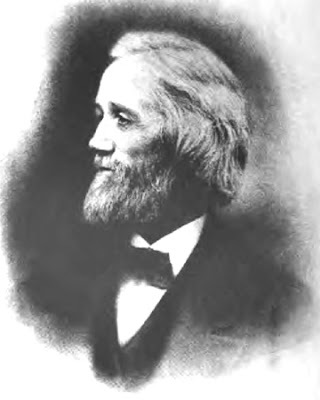
THE BIRTH OF
THE TYPEWRITER
G'day folks,
American newspaper editor Christopher Latham Sholes was granted a patent in 1868 for a typewriter. There are claims by others to have invented the machine, but Sholes is widely believed to have produced the first commercially successful model.
It was hardly an original idea. Back in 1714 it was announced on behalf of Queen Anne of Great Britain that Henry Mill, an engineer, born in 1683, had been granted a patent by the Queen for a writing machine. The patent notice read:
“Our Trusty and welbeloved Henry Mill, gent., hath by his petiçon humbly represented unto Us that he hath by his great study and paines & expence invented and brought to perfection an artificial machine or method for impressing or transcribing of letters, one after another, as in writing, whereby all writing whatsoever may be engrossed in paper or parchment so neat and exact as not to be distinguished from print; that the said machine or method may be of great use in settlements and publick records, the impression being deeper and more lasting than any other writing, and not to be erased or counterfeited without manifest discovery.”
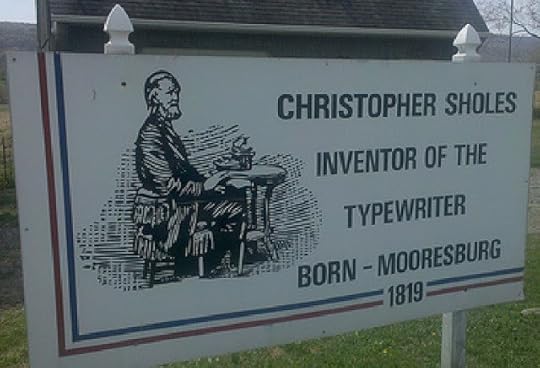
Nobody knows what the apparatus looked like or how it worked and there have been patents registered by others for machines that could pass as a typewriter. But credit for the first modern version goes to Christopher Sholes, who lived in Milwaukee, Wisconsin.
The problem with his first machine was that the keyboard was arranged alphabetically, just as anyone would expect. But as operators learned to type at speed it was discovered that the metal arms bearing each character often became entangled.
Sholes studied the problem with his partner Amos Densmore and worked out which letters were most often used. They then put them as far apart as possible on a new keyboard, reducing the chance of clashing arms because they would come from opposite directions. And thus the “Qwerty” keyboard, still is use today, was born.
Sholes was as pleased as punch with his “Qwerty” typewriter and described it as “a blessing to mankind.” Even so, he sought expert advice and opinion and in early 1873 approached engineers at the Remington company which, apart from firearms, made sewing machines and farm tools.
Remington were highly impressed and offered to buy the patent from the partners. Sholes agreed and accepted $12,000 for his half-share. The more canny Densmore, however, would not sell unless the company agreed to pay him royalties. It has been estimated that these were eventually worth $1.5 million to the astute partner.
Thanks to Sholes and Densmore, Remington began producing typewriters just a few months later. One of their early customers was Samuel Clemens, better known as Mark Twain. The Adventures of Tom Sawyer, one of Twain’s most successful works, published in 1876, is widely believed to be the first novel written on a typewriter.

May 27, 2022
15 July 2022 - HISTORIC TINY TOWN IN BULGARIA
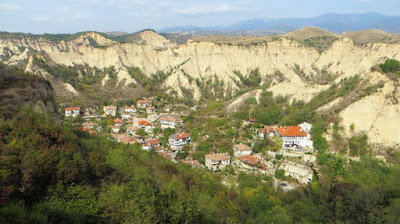
HISTORIC TINY TOWN
IN BULGARIA
G'day folks,
This tiny Bulgarian town offers a stunning location in the mountains and also has a storied history.You can see a lot in Melnik (Мелник). Sweeping mountain vistas, quaint city streets and picturesque valleys are all plentiful, as are fantastic markets and great bottles of wine.
But the most interesting thing you might come across is this number: 385. That’s the number of residents in this tiny Bulgarian hamlet, and many would say they’re 385 of the luckiest people on Earth.
Melnik is the smallest city in Bulgaria by a wide margin – in fact, it’s only able to maintain its status as an incorporated city in somewhat honorary fashion, due to the city’s storied history. In fact, nearly 100 of its barely-more-than-that buildings are designated historic landmarks.
Founded more than 1,000 years ago in the 9th century, Melnik has changed hands numerous times as war swept Europe over the centuries, at different times belonging to the Bulgarian Empire, the Ottoman Empire, Bulgaria, Russia, and then Bulgaria once more.
The remote city is nestled in the Pirin Mountains, making both travel and residency difficult for citizens. The locals swear by this quiet and reserved isolation however, and visitors are quick to note the quaintness of the town, with its small cafes and old-world atmosphere instantly transporting tourists to something of a land that time forgot.


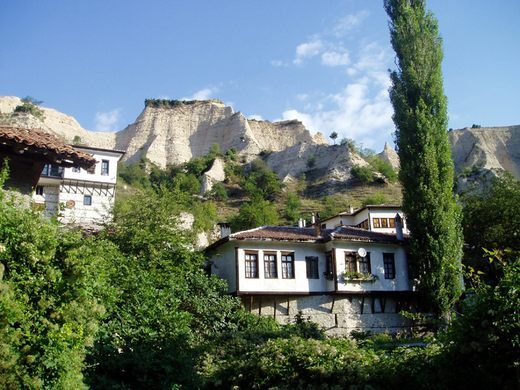
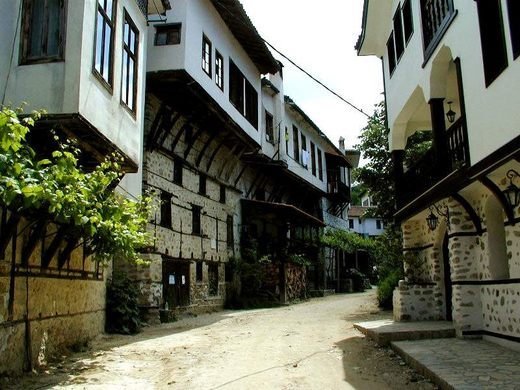

It’s no wonder then, that Melnik has developed a robust and celebrated winemaking tradition, that most ancient of crafts, and one which is perfectly suited for its agrarian surroundings. Of course, that wine is the main cash crop of the sleepy town and brings delight to the locals as well as visitors. Sir Winston Churchill reportedly ordered 500 liters of Bulgaria’s Melnik wine every year leading up to and through World War II.
Melnik is also famous for the medieval Rozhen Monastery (Роженски Манастир). The monastery is a ten-minute drive or a pleasant hike from Melnik. There are well-preserved frescoes, stained glass windows, unique carvings, and buildings from the many different historical periods in the life of the monastery. The Bulgarian Orthodox Church and the many monasteries it founded are still revered, if now little used by either monks or worshippers. That reverence is devotional, of course, for some, but throughout Bulgaria the monasteries remain compelling because of their crucial role in preserving and spreading Bulgarian literacy, culture and identity during five centuries of Ottoman rule.
The town is an architectural park and all newly built houses must comply with the Bulgarian Revival architecture. The most visited house is the Kordopulov House, a private museum. Beneath it the ruins of the family church St. Barbara are also worth a stop.
Of all once over 70 churches in town, only 3 are still functioning. One of the most important ones is the church St. Antony, the only one dedicated to this saint in Bulgaria. It’s believed that mentally ill patients can cure themselves by spending several nights under the church’s roof. Unlike most Bulgarian orthodox churches, the walls in this one are covered not in biblical scenes, but in more tranquil paintings of flowers and plants.
If visiting Melnik on a sunny day and you’re up for a little hike, don’t miss to go all the way up to St. Nicholas plateau. You’ll find the magnificent ruins of several churches, monasteries and Despot Slav’s fortress walls. The views to the magical Melnik Pyramids are breathtaking from there.
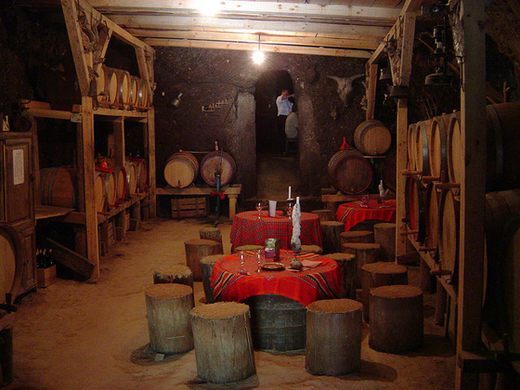
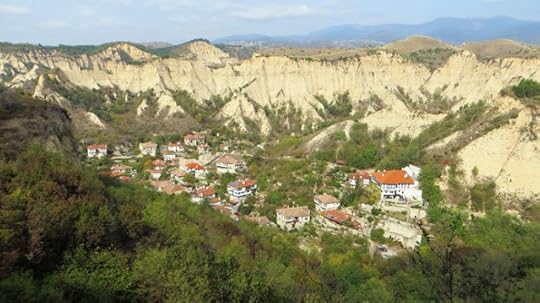
23 July 2022 - SAINT CABRINI NOVITIATE - NEW YORK
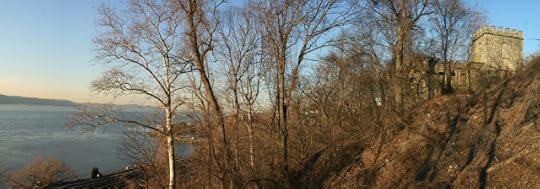
SAINT CABRINI
NOVITIATE
- NEW YORK -
G'day folks,
This dilapidated castle-like structure overlooks the Hudson River at one of its widest points and was once home to nuns.The St. Cabrini Novitiate’s castle used to offer some stunning vistas of the Hudson River from its large windows. But they’re shuttered, and the structure’s sits in disrepair amid thickets of trees and shrubs that threaten to overgrow it. Next door is the modern-looking St. Cabrini Nursing Home. The castle’s ultimate fate remains unknown after reports in the early part of the 21st century that it would be demolished.
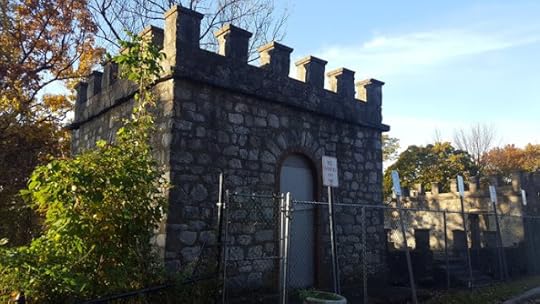

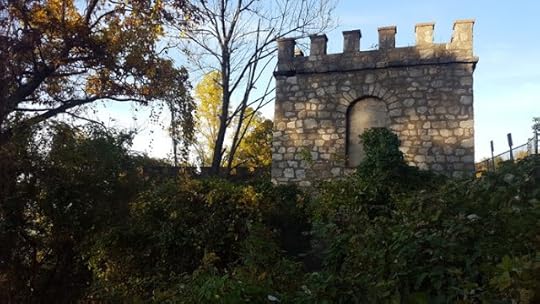
Situated on a bluff above the river bank, the castle has three levels, the top of which is close to even with the nursing home’s parking lot. The building has been described as a hodgepodge of architectural styles, but its edifice is beginning to show signs of weathering. The building served as part of a novitiate, which was a community for nuns-in-training, or novices, who lived together as they prepared to take their final vows. The nuns ran a hospital on the site.
Frances Xavier Cabrini, who emigrated to the U.S. from Italy in the 1800s at the behest of the pope, founded the novitiate around the turn of the century. She also founded the order of the Missionary Sisters of the Sacred Heart and close to 70 instituions across the United States. Cabrini is the first U.S. citizen to be canonized.
Curiosity seekers can catch a glimpse of the structure from the train while taking Metro North’s Hudson Line train. The castle is just south of the Dobbs Ferry Station.
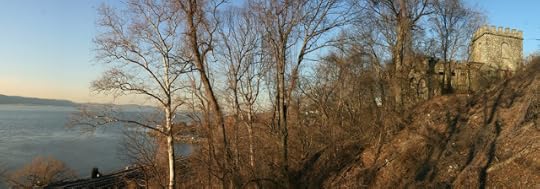
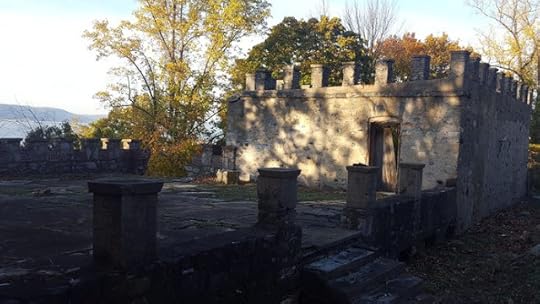
May 25, 2022
22 July 2022 - GORGEOUS WYSTERIA TUNNEL - JAPAN

GORGEOUS WYSTERIA
TUNNEL
- JAPAN -
G'day folks,
Welcome to an exquisite tunnel of cascading flowers.
It’s practically impossible to walk through the pastel-colored passageway of wisteria flowers at the Kawachi Fuji Gardens in Kitakyushu without imagining an elegant fairy princess and her one-horned white steed prancing alongside you.

A member of the pea family, wisteria is an ornamental vine, wildly popular in both Eastern and Western gardens for its graceful hanging flowers and its ornate, winding branches. Easily trained, the woody vines tend to reach maturity within a few years, at which point they bloom in cascades of long, lavender flowers of varying pastel shades. There are about 150 flowering wisteria plants of roughly 20 species that create this famous colorful flower tunnel.
Make sure to visit in late April or Early May, during the “Fuji Matsuri,” or “Wisteria Festival,” when the magical tunnel is in full bloom. Because many visitors come to the gardens during the blooming season, you need to book your time slot in advance.
Arrive at any other time of year, and its appearance will be a disheartening mass of lifeless, twisted branches.

May 21, 2022
21 July 2022 - DEVIL'S SLIDE TRESTLES - COLORADO
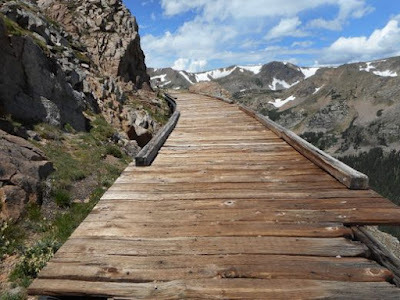
DEVIL'S SLIDE TRESTLES
- COLORADO -
G'day folks,
These decaying bridges 1,000 feet high are a reminder of the skill it took to cross the Colorado Rockies by rail.Built in 1905 at a total elevation of 11,600 feet on the edge of South Boulder Canyon in the Colorado Rockies, the Devil’s Slide Trestles cling to the side of a mountain with only oblivion between them and the waters of Middle Boulder Creek nearly 1,000 feet below.
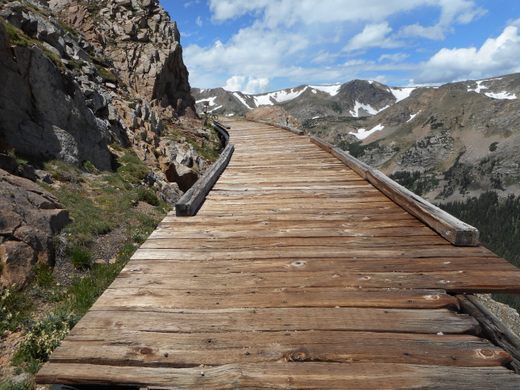
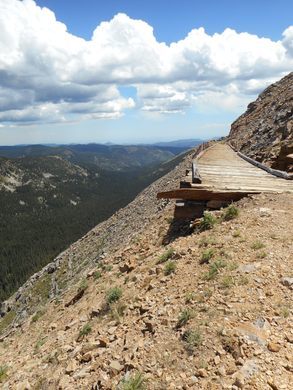

The twin train trestles were part of a harrowing and dangerous railroad that climbed up and over the Colorado Front Range to connect Denver to Winter Park and Salt Lake. This route was part of the historic Moffat Road, one of the highest standard-gauge, non-cog railroads built in the United States. For two decades, the trestles provided an unnerving passage to passengers of the Denver & Salt Lake Railway, until the route was abandoned in 1928 with the opening of the 6.3-mile Moffat Tunnel.
In 1955, the road was opened to automobile traffic following the removal of the train tracks in 1938. But this did nothing to alleviate the unsettling experience of crossing these high bridges. Following the collapse of a tunnel in 1990, the trestles, decaying from nearly 100 years of Colorado’s extreme weather, were closed to automobile and pedestrian traffic. Today, the trestles are not safe to cross, but can be seen by hiking or mountain biking the trail out to the site from either the east or west side of the pass. Looking at the twin trestles you can imagine what it was like to traverse these rickety bridges, with nothing but air between you and the cold waters of Middle Boulder Creek.
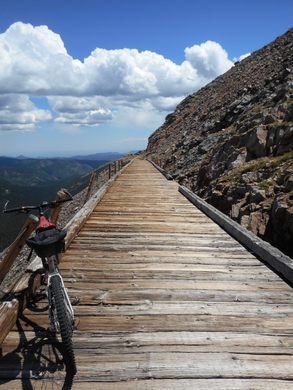
12 July 2022 - AKIYOSHHIDO CAVE - JAPAN
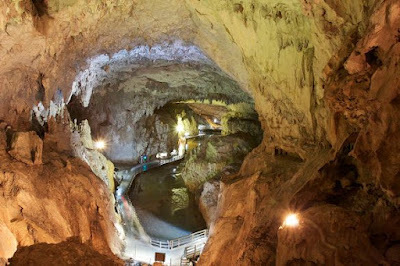
AKIYOSHHIDO CAVE
- JAPAN -
G'day folks,
Approximately 300 million years ago, a massive coral reef existed in what is now the largest limestone cave in Japan.Deep within the mountains of Yamaguchi Prefecture lies Akiyoshido Cave, the longest network of limestone caves in Japan. While the total length of the cavern is nine kilometers (5.5 miles), about one kilometer (0.6 miles) of the cave is open to explore. These chambers are beautifully illuminated and are easily traversed via built up walkways.
There are three entrances to Akiyoshido Cave: the Akiyoshido Entrance, the Kurotani Entrance, or through an elevator.



The chambers of the cave are decorated with an abundance of stalactites and terraces. Within the caves is a large underground lake, which can be comfortably appreciated from the walkway. The water from this lake feeds into a waterfall at the cave’s opening. This waterfall can also be admired from the walkway. Towards the end of the caves is a colorfully illuminated tunnel, this serves as a tribute to the evolution of the human race throughout the ages.
Just outside the caverns are also several hiking trails that wind through the Akiyoshidai Plateau. These trails weave through a hilly landscape littered with fragments of limestone. Some 300 million years ago, the plateau was the site of a coral reef. Over time, the limestone eroded into the formations that we see today.
Akiyoshidai is a wondrous place to visit all year round, with each season presenting the caves from a unique angle.

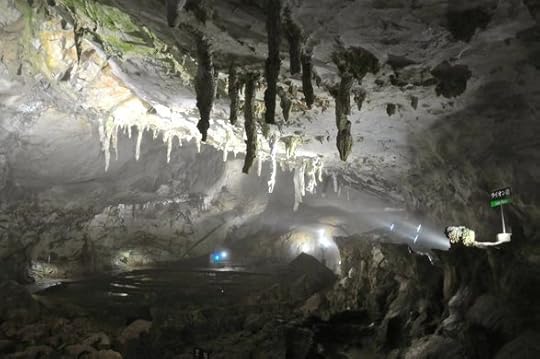
May 20, 2022
7 July 2022 - SPAIN'S WAR AGAINST THE U.S.A.
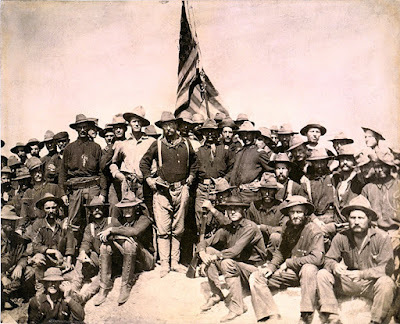
SPAIN'S WAR
AGAINST THE U.S.A.
G'day folks,
Explorer Christopher Columbus landed on Cuba's northeastern coast in 1492 and claimed the island for the new Kingdom of Spain, which had sponsored his journey of discovery. For the Cuban people, there followed 400 years of slavery, degradation and rebellion.
Here’s what Columbus wrote about them in his diary: “They brought us parrots and balls of cotton and spears and many other things, which they exchanged for glass beads and hawks’ bells.
“They willingly traded everything they owned. They do not bear arms, and do not know them, for I showed them a sword, they took it by the edge and cut themselves out of ignorance. They have no iron.
“They would make fine servants. With fifty men we could subjugate them all and make them do whatever we want.”
This became the policy of the Spanish who took over Cuba following Columbus’s discovery. Resentment simmered among the islanders but it was not until 1868 that a major rebellion erupted resulting in what became known as the Ten Years' War, with 200,000 Spanish casualties.
In 1892 the Cuban Revolutionary Party was formed with the aim of achieving independence from Spain. The Spanish reacted with suppression, creating “reconcentrados” – fortified towns that are seen as forerunners of the Second World War concentration camps. Up to 400,000 Cubans died from starvation and disease in the “reconcentrados”.
As rioting took hold in Havana, the United States sent in a battleship – the USS Maine – “to protect American interests”. But within days of anchoring in Havana harbour the Maine was ripped apart by an explosion, killing three quarters of the crew – about 250 men.
The cause of the explosion was never established but some American newspapers – particularly William Randolph Hearst’s New York Journal – had no doubt: it must have been a Spanish mine.
As hysterical headlines poured off the presses, public opinion veered towards war amid chants of “Remember the Maine! To Hell with Spain!” Congress demanded independence for Cuba and authorised the use of force to achieve such an end.
Spain at first severed diplomatic relations but then on April 24, 1898 declared war against the United States. The next day Congress in turn declared war on Spain.
The war lasted for ten weeks, America’s far superior forces inevitably gaining victory over the Spanish.
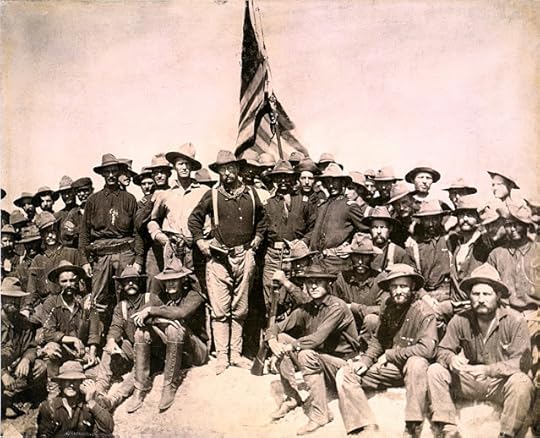
Probably the most famous encounter came on July 1 when Colonel Theodore Roosevelt – who was to become US President in 1901 – led the 1st United States Volunteer Cavalry, known as the “Rough Riders,” in the Battle of San Juan Hill. He did so carrying a pistol recovered from the Maine.
Task & Purpose, a military and veteran-focused website, reports: “[It was] a bloody struggle to gain the high ground above enemy naval concentrations in the harbor of nearby Santiago de Cuba.
“The action cost [the US] over 1,000 soldiers – nearly five times as many as the Spanish – but despite the grave loss of life, Roosevelt overtook the enemy position and carried the day.”
Two days later the Spanish fleet was destroyed at the Battle of Santiago de Cuba, leading to surrender of the city.
After the war Spain and the United States signed the Treaty of Paris under which Spain ceded Puerto Rico, the Philippines, and Guam to the US for $20 million and Cuba became a protectorate of the United States.
It gained independence from the US in 1902 and would not hit international headlines again until President John F. Kennedy faced down Soviet leader Nikita Khrushchev in the Cuban Missile Crisis of 1962.
May 17, 2022
6 July 2022 - SOLO AROUND THE WORLD IN 1898
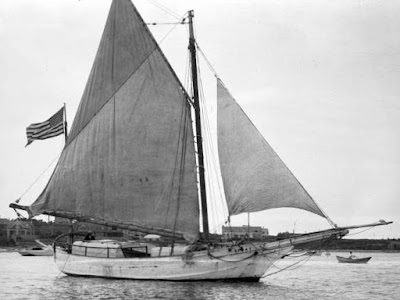
SOLO AROUND THE
WORLD IN 1898
G'day folks,
Joshua Slocum stepped ashore at Newport, Rhode Island in 1898 after sailing alone around the world. He was the first person to achieve such a feat and did it, he wrote, “because I was amused by the assertions that it could not be done.”
What made the voyage even more remarkable was that Slocum accomplished it in a decrepit 37-foot (11.2m) fishing boat which he had rebuilt and named Spray.
Showing himself to be a fine writer as well as an extraordinary sailor, Slocum told of his adventure in a book called Sailing Alone Around The World. In it he described his departure from Boston, Massachusetts:
“I had resolved on a voyage around the world, and as the wind on the morning of April 24, 1895 was fair, at noon I weighed anchor, set sail, and filled away from Boston . . . The twelve o'clock whistles were blowing just as the sloop shot ahead under full sail . . . and swung past the ferries with lively heels . . .
“A thrilling pulse beat high in me. My step was light on deck in the crisp air. I felt there could be no turning back, and that I was engaging in an adventure the meaning of which I thoroughly understood.
“The day was perfect, the sunlight clear and strong. Every particle of water thrown into the air became a gem, and the Spray, making good her name as she dashed ahead, snatched necklace after necklace from the sea . . .
“We have all seen miniature rainbows about a ship’s prow, but the Spray flung out a bow of her own that day, such as I had never seen before. Her good angel had embarked on the voyage; I so read it in the sea.”

More than three years later, on June 27, 1898, Slocum ended his voyage at Newport, Rhode Island. His route had taken him to Nova Scotia, the Azores, Gibraltar, South America, Samoa, Australia, South Africa and the West Indies. He had sailed 46,000 miles (74,000 km) in three years, two months, and two days.
Astonishingly, his return was almost unhailed – but only because the Spanish-American war was raging at the time and occupying almost everyone’s attention. In fact, the harbour had been mined against the possibility of a Spanish naval attack, adding to Slocum’s difficulties.
Describing the final leg of his incredible journey he wrote: “It was close work but it was safe enough as long as the Spray hugged the rocks, and not the mines.”
Born in 1844 in Nova Scotia, Slocum first went to sea at the age of 16 aboard a merchant ship to Ireland. The sea was then in his blood and he spent the rest of his life travelling to ports around the world. During an extended stay in the US he became a naturalised American citizen.
By 1909, Slocum had told friends that his next adventure would be to explore the Orinoco, Rio Negro and Amazon rivers, but on November 14, that year he set sail in the Spray for the West Indies on one of his usual winter voyages.
He was never seen or heard from again. In July 1910, his wife issued a statement saying she believed that her husband, who had never learnt to swim, was lost at sea. In 1924, Joshua Slocum was legally declared dead.
May 15, 2022
5 July 2022 - TITO'S BLUE TRAIN - SERBIA
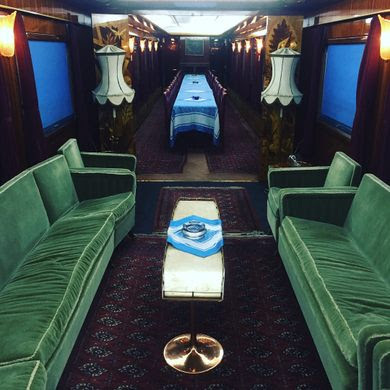 TITO'S BLUE TRAIN - SERBIA -
TITO'S BLUE TRAIN - SERBIA -G'day folks,Ride in 1960s style on the private luxury train Marshal Josip Tito used to travel around Yugoslavia.
In an unassuming railway depot south of Belgrade lies a relic of a forgotten era. Built in a time when Yugoslavia was recovering from the Second World War, this iconic blue train served to transport the country’s leaders around the different republics of Yugoslavia, and entertain foreign dignitaries so critical to the diplomatic success of the socialist nation.
The Blue Train, Marshal Josip Tito’s private train, was built with luxury in mind. Tito preferred to travel by rail, and as Yugoslavia became more prosperous in the years after the war, the train reflected the optimism and wealth of its primary user, if not that of the average citizen.
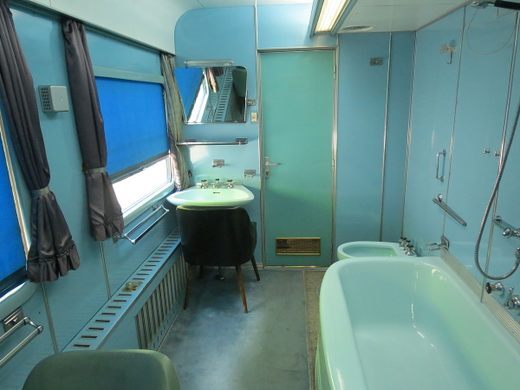
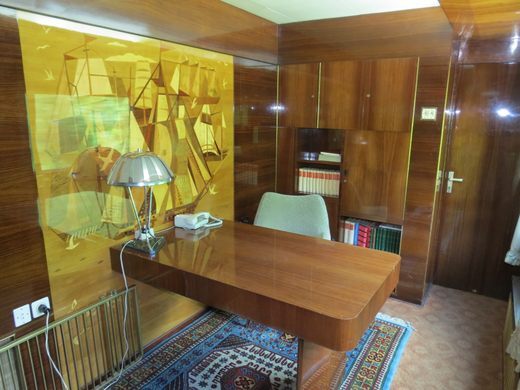
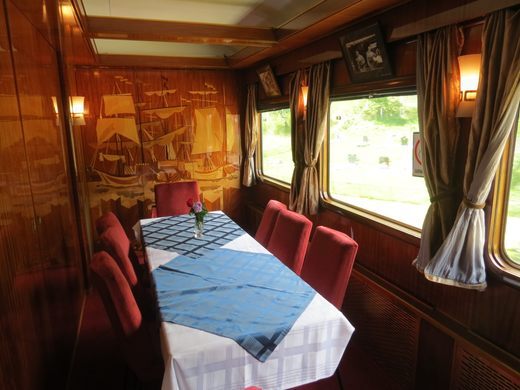
Custom-built coaches were decorated in a simple yet modern socialist realist style, with certain classical holdovers such as intricate mosaics and dark hardwood lining. The overall effect is one of understated power, which comes as no surprise considering some of the train’s clientele.
Used often by Tito for domestic purposes, the Blue Train also served an important diplomatic role. Its guest list is a veritable who’s-who of 1960s power players, from Queen Elizabeth to Charles de Gaulle to Yasser Arafat. It’s easy to imagine diplomats and party officials seated around the massive main dining table or crammed into the modernist, Zodiac-themed bar, as Tito sought to provide the world a path between the American-led West and the Soviet sphere of influence.
It’s still possible to enjoy the splendor of the Blue Train, which has been remarkably preserved in its original state. If your pocketbook is big enough, you can do so as Tito did: for a hefty fee, the Serbian Railways will hook up the train for a trip on the spectacular Belgrade-Bar railway. The line is one of Tito’s biggest public works projects and one of the most scenic rail journeys in Europe; the 296-mile route between the Serbian capital and the Montenegro coast passes over 435 bridges and through 54 tunnels.
For those whose wallets aren’t quite as fat, it’s still possible to enjoy the Blue Train, and walk through the very same cars where Haile Selassie sat, Queen Elizabeth dined, and Josip Broz Tito slept.


9 July 2022 - FORGOTTEN WAR MEMORIAL - WASHINGTON D.C.
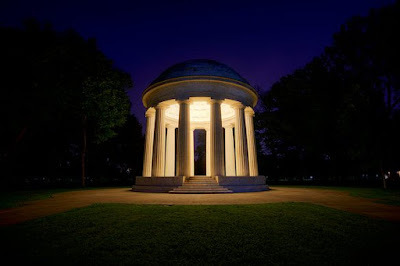
FORGOTTEN WAR
MEMORIAL
- WASHINGTON D.C. -
G'day folks,
Welcome to an overlooked memorial honoring the local Washington residents who died in World War I.
The first letters started a month after the war ended. People were writing the government with the idea of building a monument honoring the more than 26,000 Washington, D.C. residents who had served in World War I. Thirteen years later in 1931, the D.C. War Memorial was dedicated by President Herbert Hoover. This little-known monument is the only memorial dedicated to District residents on the National Mall.
Frank and Janet Noyes, a prominent newspaper family at the time, agreed to fund the project. Janet also had a hand in the design, proposing that the monument replace an old wooden bandstand in West Potomac Park. The new memorial would even resemble a bandstand: She suggested a domed marble memorial that would honor the dead and be available for military bands to use to play tribute to these soldiers.
Six years after the war ended, the first planning committee for the memorial met, and building began another four years later. Since the memorial was to honor local veterans, the people of D.C. thought it was important to use a local construction company. “Construction of the war memorial by out-of-town agencies would violate the principle and do injustice of the people of our city,” noted the District’s Chamber of Commerce president Harry King. A local builder was chosen from the bids, and the 47-foot-tall monument, comprised of 12 columns supporting a domed roof, was finally erected.
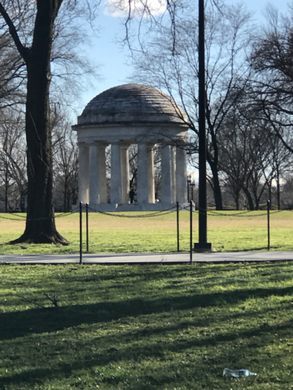


Rather than the initial idea of honoring all of the D.C. residents who served, the monument pays tribute to the 499 Washington residents who died in the war. Besides being dedicated to D.C. residents, the monument has another distinction; in an unusual move for the time, the inscription includes the names of both men and women.
The first concert held in the monument was during its dedication on November 11, 1931. It was lead by noted composer John Phillip Sousa, and the space became a popular gathering spot for visitors to listen to music. However, as musical tastes changed, the kind of music that filled the bandstand wasn’t bringing the crowds it used to, and concerts happened there much less often. The monument, because of its off the beaten path location, or changing entertainment tastes, or a little of both, went through a period of neglect. In 2003, the memorial was declared one of D.C.’s most endangered places by the DC Preservation League.
In 2010, $3.6 million was dedicated to restore and upgrade the space. This hidden treasure, tucked among the trees, honors the veterans of a war that is quickly fading from public memory.





